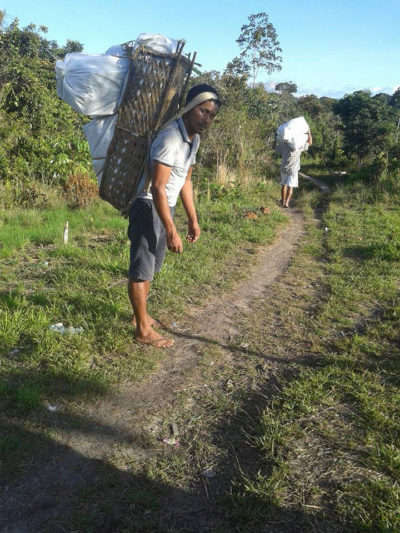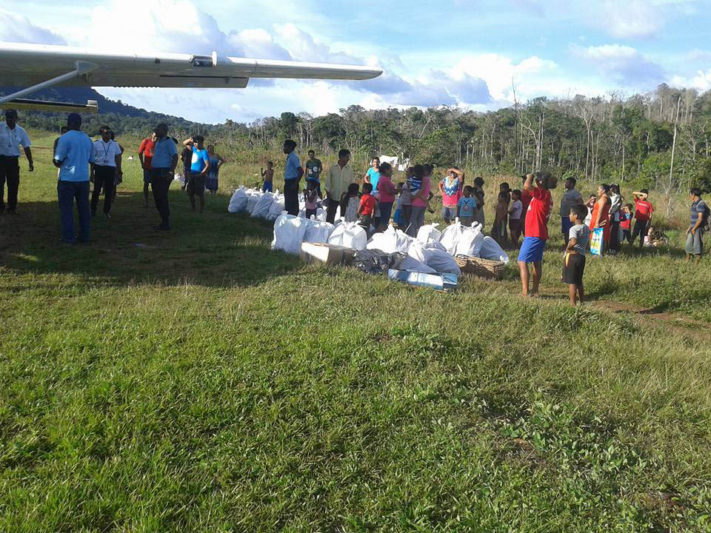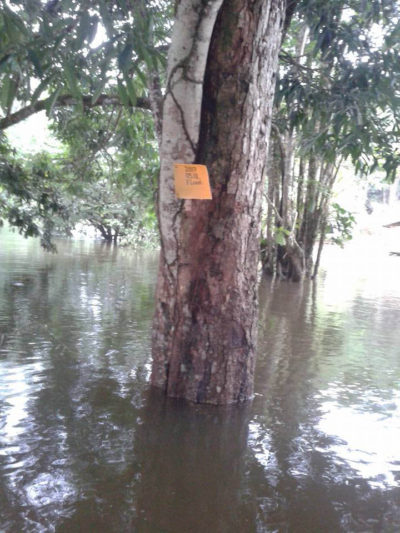Water levels in the Region Eight villages affected by recent flooding are receding, according to the Civil Defence Commission (CDC), which yesterday also reported that several areas in Region Seven had also been affected and disaster management systems had been activated there.
As emergency supplies continued to be delivered to distressed Region Eight residents, the CDC, via a press statement issued by the Department of Infor-mation yesterday afternoon, said that in addition to the six indigenous villages affected in Region Eight, new reports reveal-ed that several villages in Region Seven were also faced with flooding.
It was further noted that while farmlands and some residences in the Cuyuni-Mazaruni district were flooded, the situation there is less severe when compared to what is happening in Region Eight.
Nevertheless, the Region Seven Regional Disaster Risk Management Systems (RDRMS) and Regional Disaster Risk Management Committee (RDRMC) have been activated and a team will also be deployed to the affected villages to conduct assessments and reconnaissance, the CDC said.
The flooding in both regions comes in wake of excessive rainfall in the highland regions over the past few days, coupled with the cresting of the Ireng River. The affected villages include Kaibaru-pai, Waipa, Chenapau, Sand Hill Settlement, Itabac and Kanapang in Region Eight, and Purima, Kako, Jawalla, Phillipai, Kamarang and Duebamang in Region Seven.
The CDC and the Ministry of Public Health were yesterday able to dispatch four planeloads of relief supplies to Chenapau and Orinduik, in addition to the three which were dispatched on Friday afternoon. Food, water, clothing and medication are currently being shuttled to villages up river from the fully functional logistics centre at Orinduik.
‘Emergency situation’
The Amerindian Peoples’ Association (APA), which has been helping to coordinate the relief efforts for the affected areas, yesterday said that though the water in the Ireng River has receded by an estimated eight feet, it remains “very high.”
Photographs posted by Toshao Edward McGarrell, of Chenapau Village, showed a significant decrease in flood waters. The Toshao was also able to confirm that two shuttles from the CDC delivered supplies to the village yesterday.
Based on information supplied by personnel on the ground in Waipa, the water level there has receded by at least 15 feet, while all residents have since been accounted for. However, the request for food and other supplies remains the same.
In Kanapang, an estimated 90 farms have been submerged, while a school in Itabac Village has been washed away, and 47 farms have been destroyed.
Reports coming from Toshao John Salvador, of Kaibarupai, indicated that the water has started to recede and the village’s communication system is once again up and running.
Meanwhile, the APA said that as of yesterday morning, residents of Kaibarupai, particularly children and the elderly, were facing an “emergency situation,” as supplies had not yet reached the village, and there were in dire need of food. “They have been hard hit and are in need of food supplies urgently. The APA is in the process of taking food supplies to Mahdia for shipment to Orinduik, from where it will be boated upriver to the affected communities,” the organization said in an update posted on its Facebook page.
Stabroek News understands that the bus arrived in Mahdia and efforts were being made to have the emergency supplies transported to the villages in a timely manner.
The CDC also said Minister within in the Ministry of Indigenous Peoples’ Affairs Valerie Garrido-Lowe led a team to Waipa and Kaibarupai with relief supplies consisting mainly of food, medicine, clothing and water purification agents.
The CDC thanked Food for the Poor, Banks DIH Limited, Nand Persaud and Company, Ansa McAl, and Dunae Trading Company for generous donations towards the flood relief efforts, which it said have assisted significantly in bolstering the flood relief stocks. It also thanked the APA for coordinating relief supplies of food, clothing and other items.
Members of the public who wish to make donations to the flood relief efforts are asked to do so at the CDC headquarters on Thomas Road. The CDC’s telephone numbers are 226-1114, 226-8815, 226-1027, and 225-5847, and its email addresses are info@cdc.gy and opsandtrg.cdcgy@gmail.com.








